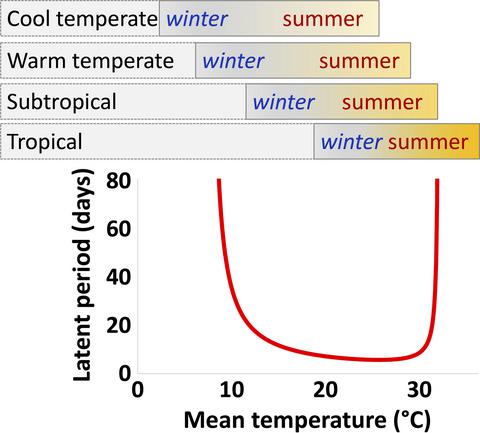当前位置:
X-MOL 学术
›
Plant Pathol.
›
论文详情
Our official English website, www.x-mol.net, welcomes your
feedback! (Note: you will need to create a separate account there.)
Symptom development and latent period of Austropuccinia psidii (myrtle rust) in relation to host species, temperature and ontogenic resistance
Plant Pathology ( IF 2.3 ) Pub Date : 2020-01-28 , DOI: 10.1111/ppa.13145 Robert M. Beresford 1 , Louise S. Shuey 2 , Geoff S. Pegg 2
Plant Pathology ( IF 2.3 ) Pub Date : 2020-01-28 , DOI: 10.1111/ppa.13145 Robert M. Beresford 1 , Louise S. Shuey 2 , Geoff S. Pegg 2
Affiliation

|
Abstract Myrtle rust (Austropuccinia psidii) is an invasive species causing damage to Myrtaceae species in natural and managed ecosystems in many countries. To better understand myrtle rust epidemiology we studied latent period (LP) and ontogenic resistance in relation to temperature on three susceptible hosts (Metrosideros excelsa, Lophomyrtus bullata × L. obcordata and Syzygium jambos). The latent period curve was U-shaped, with latent development >0 from between 8 and 10 °C, depending on the host, to 32 °C. Optimum range was 22–28 °C with minimum LP of 5–7 days. Peak spore production occurred over about 2 weeks, starting about 1 week after the LP ended. Some spore production continued for 1–2 months. Comparison of the LP data with field temperatures indicated that the uredinial stage of A. psidii can overwinter in the latent phase in temperate areas of New Zealand and southern Australia and, therefore, uredinial or telial reinfection is not required during winter. The LP information was used to correct the LP function in a New Zealand myrtle rust climatic risk model. The transition of emergent leaf and stem tissues in susceptible Myrtaceae genotypes from susceptible to immune (ontogenic resistance) was characterized in terms of uredinium density and LP. Onset of ontogenic resistance was closely linked to the degree of leaf expansion, with fully expanded leaves being immune to infection. Because ontogenic resistance restricts infection to periods when growth flushes occur, understanding it is crucial for explaining the seasonality of myrtle rust development in the natural environment.
中文翻译:

Austropuccinia psidii(桃金娘锈病)的症状发展和潜伏期与宿主物种、温度和个体发生抗性的关系
摘要 桃金娘锈病(Austropuccinia psidii)是一种入侵物种,在许多国家的自然和管理生态系统中对桃金娘科物种造成损害。为了更好地了解桃金娘锈病的流行病学,我们研究了三种易感宿主(Metrosideros excelsa、Lophomyrtus Bullata × L. obcordata 和 Syzygium jambos)上与温度相关的潜伏期 (LP) 和个体发生抗性。潜伏期曲线呈 U 形,潜伏期从 8 到 10 °C(取决于宿主)到 32 °C 之间 >0。最佳范围为 22–28 °C,最低 LP 为 5–7 天。从 LP 结束后约 1 周开始,约 2 周内出现峰值孢子产生。一些孢子生产持续了 1-2 个月。LP 数据与田间温度的比较表明 A. psidii 可以在新西兰和澳大利亚南部温带地区的潜伏期越冬,因此,冬季不需要再次感染尿尿或冬虫夏草。LP 信息用于校正新西兰桃金娘锈病气候风险模型中的 LP 函数。易感桃金娘科基因型中的出苗叶和茎组织从易感到免疫(个体发生抗性)的转变以 urdinium 密度和 LP 为特征。个体发生抗性的发生与叶片扩张的程度密切相关,完全扩张的叶片对感染免疫。由于个体发生抗性将感染限制在发生生长潮的时期,因此了解它对于解释自然环境中桃金娘锈病发展的季节性至关重要。因此,在冬季不需要尿尿或 telial 再感染。LP 信息用于校正新西兰桃金娘锈病气候风险模型中的 LP 函数。易感桃金娘科基因型中的出苗叶和茎组织从易感到免疫(个体发生抗性)的转变以 urdinium 密度和 LP 为特征。个体发生抗性的发生与叶片扩张的程度密切相关,完全扩张的叶片对感染免疫。由于个体发生抗性将感染限制在发生生长潮的时期,因此了解它对于解释自然环境中桃金娘锈病发展的季节性至关重要。因此,在冬季不需要尿尿或 telial 再感染。LP 信息用于校正新西兰桃金娘锈病气候风险模型中的 LP 函数。易感桃金娘科基因型中的出苗叶和茎组织从易感到免疫(个体发生抗性)的转变以 urdinium 密度和 LP 为特征。个体发生抗性的发生与叶片扩张的程度密切相关,完全扩张的叶片对感染免疫。由于个体发生抗性将感染限制在发生生长潮的时期,因此了解它对于解释自然环境中桃金娘锈病发展的季节性至关重要。LP 信息用于校正新西兰桃金娘锈病气候风险模型中的 LP 函数。易感桃金娘科基因型中的出苗叶和茎组织从易感到免疫(个体发生抗性)的转变以 urdinium 密度和 LP 为特征。个体发生抗性的发生与叶片扩张的程度密切相关,完全扩张的叶片对感染免疫。由于个体发生抗性将感染限制在发生生长潮的时期,因此了解它对于解释自然环境中桃金娘锈病发展的季节性至关重要。LP 信息用于校正新西兰桃金娘锈病气候风险模型中的 LP 函数。易感桃金娘科基因型中的出苗叶和茎组织从易感到免疫(个体发生抗性)的转变以 urdinium 密度和 LP 为特征。个体发生抗性的发生与叶片扩张的程度密切相关,完全扩张的叶片对感染免疫。由于个体发生抗性将感染限制在发生生长潮的时期,因此了解它对于解释自然环境中桃金娘锈病发展的季节性至关重要。个体发生抗性的发生与叶片扩张的程度密切相关,完全扩张的叶片对感染免疫。由于个体发生抗性将感染限制在发生生长潮的时期,因此了解它对于解释自然环境中桃金娘锈病发展的季节性至关重要。个体发生抗性的发生与叶片扩张的程度密切相关,完全扩张的叶片对感染免疫。由于个体发生抗性将感染限制在发生生长潮的时期,因此了解它对于解释自然环境中桃金娘锈病发展的季节性至关重要。
更新日期:2020-01-28
中文翻译:

Austropuccinia psidii(桃金娘锈病)的症状发展和潜伏期与宿主物种、温度和个体发生抗性的关系
摘要 桃金娘锈病(Austropuccinia psidii)是一种入侵物种,在许多国家的自然和管理生态系统中对桃金娘科物种造成损害。为了更好地了解桃金娘锈病的流行病学,我们研究了三种易感宿主(Metrosideros excelsa、Lophomyrtus Bullata × L. obcordata 和 Syzygium jambos)上与温度相关的潜伏期 (LP) 和个体发生抗性。潜伏期曲线呈 U 形,潜伏期从 8 到 10 °C(取决于宿主)到 32 °C 之间 >0。最佳范围为 22–28 °C,最低 LP 为 5–7 天。从 LP 结束后约 1 周开始,约 2 周内出现峰值孢子产生。一些孢子生产持续了 1-2 个月。LP 数据与田间温度的比较表明 A. psidii 可以在新西兰和澳大利亚南部温带地区的潜伏期越冬,因此,冬季不需要再次感染尿尿或冬虫夏草。LP 信息用于校正新西兰桃金娘锈病气候风险模型中的 LP 函数。易感桃金娘科基因型中的出苗叶和茎组织从易感到免疫(个体发生抗性)的转变以 urdinium 密度和 LP 为特征。个体发生抗性的发生与叶片扩张的程度密切相关,完全扩张的叶片对感染免疫。由于个体发生抗性将感染限制在发生生长潮的时期,因此了解它对于解释自然环境中桃金娘锈病发展的季节性至关重要。因此,在冬季不需要尿尿或 telial 再感染。LP 信息用于校正新西兰桃金娘锈病气候风险模型中的 LP 函数。易感桃金娘科基因型中的出苗叶和茎组织从易感到免疫(个体发生抗性)的转变以 urdinium 密度和 LP 为特征。个体发生抗性的发生与叶片扩张的程度密切相关,完全扩张的叶片对感染免疫。由于个体发生抗性将感染限制在发生生长潮的时期,因此了解它对于解释自然环境中桃金娘锈病发展的季节性至关重要。因此,在冬季不需要尿尿或 telial 再感染。LP 信息用于校正新西兰桃金娘锈病气候风险模型中的 LP 函数。易感桃金娘科基因型中的出苗叶和茎组织从易感到免疫(个体发生抗性)的转变以 urdinium 密度和 LP 为特征。个体发生抗性的发生与叶片扩张的程度密切相关,完全扩张的叶片对感染免疫。由于个体发生抗性将感染限制在发生生长潮的时期,因此了解它对于解释自然环境中桃金娘锈病发展的季节性至关重要。LP 信息用于校正新西兰桃金娘锈病气候风险模型中的 LP 函数。易感桃金娘科基因型中的出苗叶和茎组织从易感到免疫(个体发生抗性)的转变以 urdinium 密度和 LP 为特征。个体发生抗性的发生与叶片扩张的程度密切相关,完全扩张的叶片对感染免疫。由于个体发生抗性将感染限制在发生生长潮的时期,因此了解它对于解释自然环境中桃金娘锈病发展的季节性至关重要。LP 信息用于校正新西兰桃金娘锈病气候风险模型中的 LP 函数。易感桃金娘科基因型中的出苗叶和茎组织从易感到免疫(个体发生抗性)的转变以 urdinium 密度和 LP 为特征。个体发生抗性的发生与叶片扩张的程度密切相关,完全扩张的叶片对感染免疫。由于个体发生抗性将感染限制在发生生长潮的时期,因此了解它对于解释自然环境中桃金娘锈病发展的季节性至关重要。个体发生抗性的发生与叶片扩张的程度密切相关,完全扩张的叶片对感染免疫。由于个体发生抗性将感染限制在发生生长潮的时期,因此了解它对于解释自然环境中桃金娘锈病发展的季节性至关重要。个体发生抗性的发生与叶片扩张的程度密切相关,完全扩张的叶片对感染免疫。由于个体发生抗性将感染限制在发生生长潮的时期,因此了解它对于解释自然环境中桃金娘锈病发展的季节性至关重要。









































 京公网安备 11010802027423号
京公网安备 11010802027423号